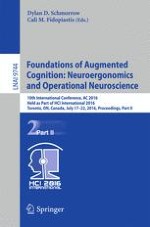2016 | Buch
Foundations of Augmented Cognition: Neuroergonomics and Operational Neuroscience
10th International Conference, AC 2016, Held as Part of HCI International 2016, Toronto, ON, Canada, July 17-22, 2016, Proceedings, Part II
herausgegeben von: Dylan D. Schmorrow, Cali M. Fidopiastis
Verlag: Springer International Publishing
Buchreihe : Lecture Notes in Computer Science
